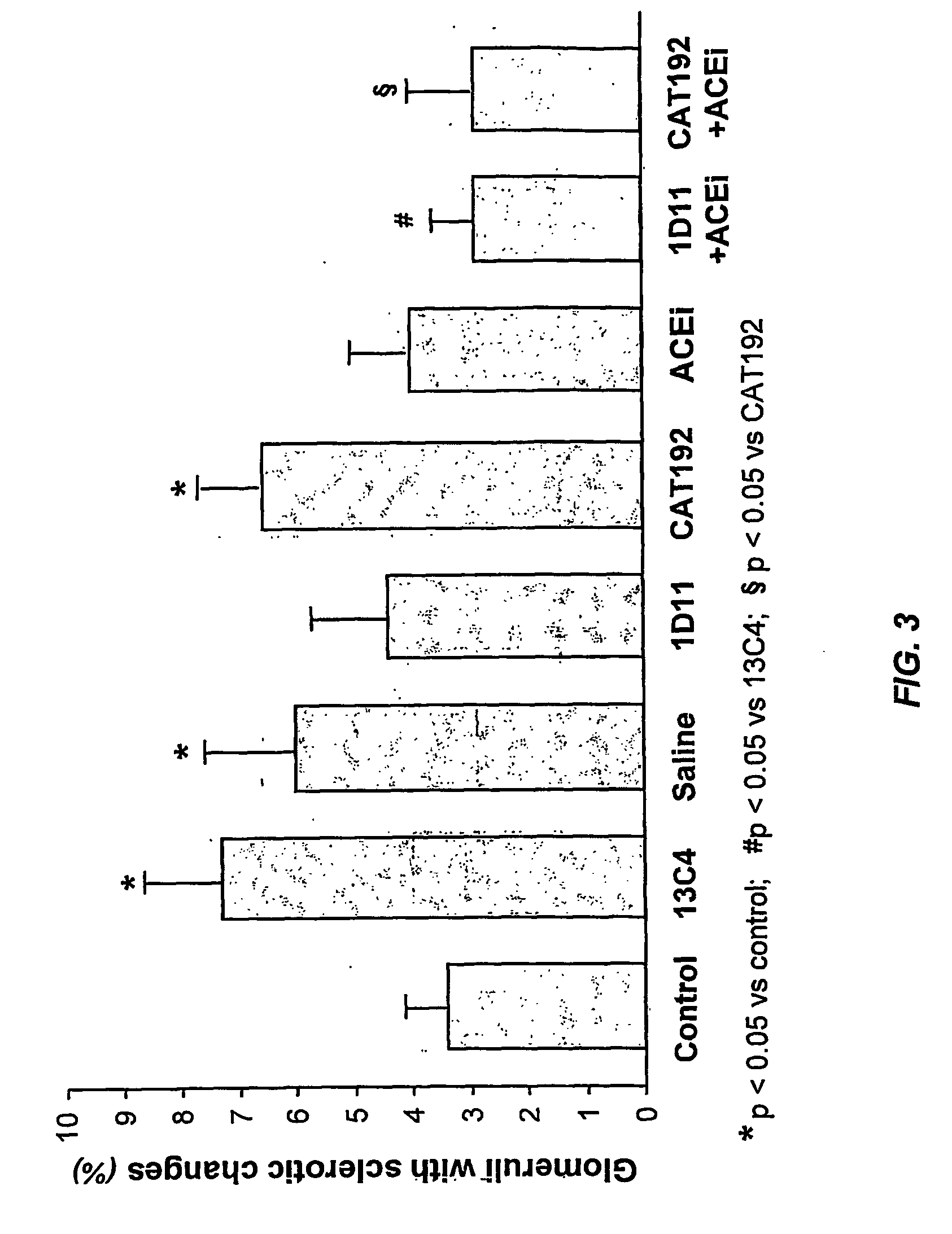Tgf-beta antagonists combined with renin-angiotensin-aldosteron-system antagonists for treating renal insufficiency
a technology of angiotensin and antagonist, applied in the field of clinical pathophysiology, can solve the problems of loss of normal kidney cells, increase in hydraulic pressure within the glomerular capillaries, loss of renal function, etc., and achieve the effects of reducing the risk of occurrence of renal insufficiency, and slowing the loss of renal function
- Summary
- Abstract
- Description
- Claims
- Application Information
AI Technical Summary
Benefits of technology
Problems solved by technology
Method used
Image
Examples
example 1
Treatment of Renally Compromised Rats with TGF-β Antagonists and / or ACE Inhibitors
[0095] Male Sprague-Dawley rats with initial body weights of 250 to 300 g were used in this study. Animal care and treatment were conducted in accordance with the U.S. National Research guidelines, 1996. All animals were housed in a room in which the temperature was kept constant on a 12-hour dark / 12-hour light cycle and allowed free access to standard diet containing 20% protein by weight and tap water.
[0096] The animals were subjected to unilateral nephrectomy under anaesthesia one week prior to the induction of diabetes to accelerate the onset of renal disease. The animals were rendered diabetic by a single intravenous (i.v.) injection of streptozotocin (STZ, Zanosar, Upjohn, Kalamazoo, Mich.; 60 mg / kg body weight). Food and water consumption, weight gain and the blood glucose levels were monitored to determine the degree of diabetes. The blood was obtained from the tip of the tails and analyzed b...
example 2
Effect of TGF-β Antagonists and / or ACE Inhibitors on Proteinuria
[0105] This example illustrates the effect of anti-TGF-β antibodies 1D11 or CAT192 alone or in combination with an ACEi on proteinuria in diabetic rats.
[0106] Animals were treated as described in Example 1. At the end of the study, twenty-four hour samples were collected using metabolic cages and proteinuria was determined by a modified Coomassie blue G dye-binding assay for proteins with bovine serum albumin as standard as described in Reed et al. (1981), Anal. Biochem. 116:53-64. Mean values (±SEM) were calculated. The significance of differences in mean values among treated groups was analyzed using an analysis of variance followed by a Duncan's multiple-range test.
[0107] The results are presented in FIGS. 1A and 1B. The results demonstrate that proteinuria was reduced in groups treated with either 1D11 alone or in combination with lisinopril and that treatment with CAT192 in combination with lisinopril also reduc...
example 3
Effect of TGF-β Antagonists and / or ACE Inhibitors on Blood Pressure
[0108] This example illustrates the effect of anti-TGF-β antibody alone or in combination with an ACEi on blood pressure in diabetic rats.
[0109] Animals were treated as described in Example 1. Systolic blood pressure at the end of the treatment period was recorded by tail plethysmography in conscious rats as described in Pfeffer et al. (1971) J. Lab. Clin. Med., 78:957-962.
[0110] As shown in FIG. 2, both 1D11 and CAT192 displayed an anti-hypertensive effect. Lisinopril limited blood pressure increase to a similar extent as 1D11. Therefore, combination of either antibody with lisinopril fully controlled systolic blood pressure.
PUM
| Property | Measurement | Unit |
|---|---|---|
| concentration | aaaaa | aaaaa |
| body weights | aaaaa | aaaaa |
| concentration | aaaaa | aaaaa |
Abstract
Description
Claims
Application Information
 Login to View More
Login to View More - R&D
- Intellectual Property
- Life Sciences
- Materials
- Tech Scout
- Unparalleled Data Quality
- Higher Quality Content
- 60% Fewer Hallucinations
Browse by: Latest US Patents, China's latest patents, Technical Efficacy Thesaurus, Application Domain, Technology Topic, Popular Technical Reports.
© 2025 PatSnap. All rights reserved.Legal|Privacy policy|Modern Slavery Act Transparency Statement|Sitemap|About US| Contact US: help@patsnap.com



